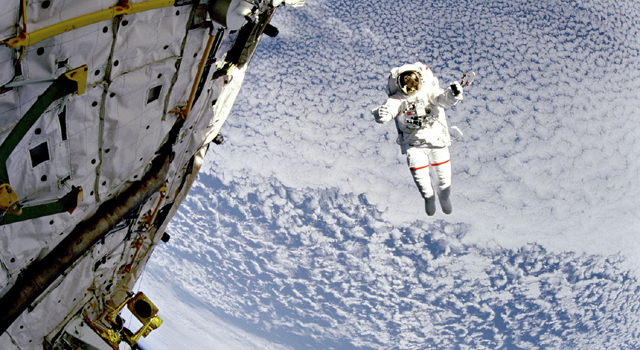
The Space industry has captured the human imagination and impacted design—and our culture—since the beginning of the last century. Not all depictions have been realistic. In Fritz Lang’s 1929 silent film The Girl in the Moon, astronauts are depicted wearing knitted cardigans for their journey! In reality mobility and working outside the spaceship necessitated the use of an Extra-Vehicular Mobility Unit (EMU) to regulate pressure, temperature, oxygen, communication and provide protection from debris and other physical hazards, while allowing for ease of movement.
There is a strong synergy between these requirements and those of sportswear design. What we have seen develop over the past century is a design and material influence on one another between sports and Space industries. This goes much deeper than individual developments and reflects, instead, an approach to innovation, particularly in materials.
All in the name
Many textiles were originally developed for the space industry, and the brand names used, such as Dacron®, Mylar® and Teflon®, were meant to evoke futuristic technology and imply a high technical performance. Phase Change Materials (PCMs) arrived in sportswear through the NASA Spinoff program. More than 500 PCMs were identified by the NASA with the intention of finding the most useful for clothing that would keep the astronauts at a comfortable temperature and meet each one’s individual needs. Outlast was the first to bring the technology to sportswear, with other manufacturers such as Schoeller Technology following.
Aerogel is another technology that has moved over to sport and fitness and is also aimed at providing climate control for the wearer. Aerogel is the lightest solid known to exist. Its properties are to offer high insulation without the addition of noticeable weight to the material. Originally referred to as “liquid smoke,” it was notoriously difficult to work with, as it would literally be crushed between human fingers if too much pressure was applied.
The European Space Agency (ESA) collaborated with the Italian manufacturer and research laboratory Grado Zero Espace in the search for commercial applications for the technology. By applying design considerations, the Italian company brings a fashion aesthetic to technologies that were primarily developed for their high performance.
Lightness
Although weight is not felt in the zero gravity of space it does impact on the payload and fuel needed for travel, so that everything, including materials, needs to be as lightweight as possible for Space travel. In addition, there is a desire to reduce bulk, because astronauts feel mass and can become uncomfortable when living and working in Space.
Dava Newman, newly appointed Deputy Administrator of NASA, developed a lightweight spacesuit based on design technology from the sports industry when she was Professor of Aeronautics and Astronautics and Engineering Systems at Massachusetts Institute of Technology (MIT). The design incorporated flexible elements to allow ease of movement, coupled with padded protective zones, in a design undertaken with motorcycle clothing manufacturer Dianese. In effect, lightness was paired with strength, which is key both to sportswear and Space travel.
Lightness in sportswear appears in many different forms from the alternation of protection with flexibility in motorcycle clothing, to weight-saving comfort-with-support in training gear. All are looking to find single materials that can do this, which is seeing the development of a body of sports materials that are functionally gradient, smart materials.
These are developments that do not happen in isolation, but through a constant flow of ideas between sports markets and the Space industry.
Marie O’Mahony is Professor of Digital Futures at Ontario College of Art + Design University, and also Visiting Professor at University of the Arts, London.
 TEXTILES.ORG
TEXTILES.ORG


